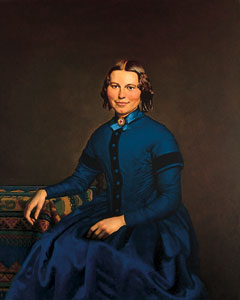Clarissa Harlow Barton was born on a cold night on December 25th, 1821, in North Oxford, Massachusetts. Her father was Stephen Barton, a state legislator and farmer, and her mother was Sally Stone. She was an extremely shy but intelligent child, the youngest of five children. She was compassionate from the very start, although she her self never had good health. When she was just eleven years old, one of her older brothers fell off of a high barn roof. Clara took care of him until she was thirteen. When she was fifteen, she was still a tremendously shy individual. Her parents encouraged her to overcome her shyness, and she went to Bordentown, New Jersey, to become a school teacher. Clara bloomed, and was suddenly able to speak in front of people with ease. She loved being a teacher, but there were not many students to teach, since the school she was at made students pay to get an education. She made a deal that if she would work for no money, than the school would be free of charge. The school agreed, and the attendance jumped from six to six hundred. She was proud of establishing the first free school in the state, and she devoted herself to teaching. Then the school hired a male super attendant. Clara became extremely stressed and starting having “breakdowns”. The breakdowns would plague her for the rest of her life. She became exhausted, and resigned from teaching to take a rest. After she recuperated, she moved to Washington D.C. She became the U.S. Patent Office’s clerk, a position that no women had had so high before. However, she felt a strong need to help the Civil War troops. Following her heart, she resigned from the office in 1861. She began to gather all kinds of medical supplies and things that the soldiers might need. Eventually, they allowed her to go onto the battlefields. Clara worked and worked and worked to save injured and sick soldiers. She was compassionate and caring, and often went the extra mile to make soldiers feel comfortable and happy. When she was 44 in 1865, she wanted to identify the huge amount of missing and dead soldiers. She ran a missing person’s office, again a first for women. She gave lectures all of the time. Clara was a strong suffragist, and meanwhile she worked to gain women’s right to vote. But soon, her health took a turn for the worst. She slowed down on her work and went to Switzerland. While trying to cure herself, she became familiar with the International Red Cross, and how it worked. But soon enough, she left Switzerland and went to France to help soldiers in the Frano-Prussian War. She gave work to dirt poor women living in Strasobourg and Lyon, teaching them to sew and other things. She improved their conditions greatly. She returned to America in 1873, wanting to start a branch of the International Red Cross and pushing for the Geneva Agreement. Sadly, her health declined rapidly and she went to a spa in New York. Even though she was a semi-invalid, she got the Geneva Agreement to be signed, which would set the standard for the caring of injured and ill soldiers, and she founded the Red Cross in America. She traveled to Michigan in 1882 to help victims of wild fires. She was the president of the Red Cross. She moved to Sherborn Massachusetts and became the super attendant of the Women’s Reformatory Prison there. She went to Charleston, South Carolina to aid earthquake victims. In 1884, she went all over the Ohio River to save people from floods. In 1889, she also helped flood victims in Johnstown, Pennsylvania. Clara traveled to Russia in 1891 to help those suffering in a famine. In 1890 she went to Turkey after the Armenian Massacres to help. At seventy years old, she wanted to help those in the Cuban Insurrection, but instead her ship was transformed into a hospital because of the Spanish-American war. Then, Clara went to Galveston, Texas, after a hurricane ravaged the city. In 1904, the Red Cross became too much for her, and she resigned. She moved to Glen Echo, Maryland. Although she was retired, she used the house as a warehouse for Red Cross supplies. Many Red Cross workers lived there with her. On April 1912, Clara passed away peacefully, at the age of 91.
Works Cited:
"Clarissa Harlow Barton." Biography Resource Center. Gale, 2000. Web. 24 Feb. 2010.
Filler, Louis. "Barton, Clara (1821-1912)." Student Resource Center- Gold. Detroit: Gale Resource, 1998. Web. 24 Feb. 2010.
"Clara Barton National Historic Site." World Book Student. World Book, 2010. Web. 24 Feb. 2010.
Subscribe to:
Post Comments (Atom)






No comments:
Post a Comment